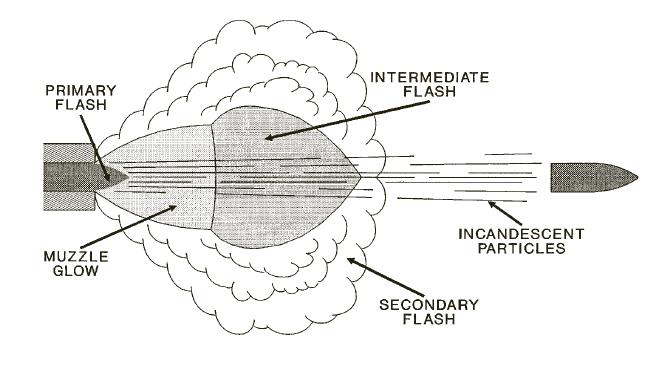
When a gun fires, only about 30% of the chemical energy released from the propellant is converted into the useful kinetic energy of actually moving the projectile down the barrel. The remaining energy is primarily contained in the propellant gas-particle mixture that escapes from the muzzle of the gun in the few milliseconds before and after shot ejection. A significant portion of this remaining energy is dissipated in the bright "muzzle flash" seen when the gun fires.
Muzzle flash consists of at least the following five components:
Muzzle Glow
Muzzle Glow is usually a reddish white glow or tongue of flame at the muzzle that appears just prior to shot ejection and persists after shot ejection until the chamber pressure drops significantly. The initial glow is usually the result of hot, highly compressed gases (unburned propellants) leaking past the projectile driving band and is brightest in a worn gun. These gasses are hot enough to emit radiation in the visible light band. A "Cold Gun" with its lubricated barrel generally shows less muzzle glow than does a "Hot Gun" with its expanded barrel.
Primary Flash
Primary Flash occurs after the projectile has exited the muzzle and is caused by those propellant gases exiting the muzzle behind the projectile. These are hot enough to emit large amounts of visible radiation but cool rapidly as they expand away from the muzzle.
Intermediate Flash
Intermediate Flash consists of a reddish disc, slightly dished towards the gun, which appears about three inches (7.5 cm) from the muzzle of a small-caliber weapon and about 20-25 calibers from the muzzle for larger caliber weapons. Intermediate Flash occurs at the time of shot ejection and persists until the chamber pressure drops. It is brightest at the edge nearest the gun and gradually fades as the distance from the muzzle increases. This flash is due to a Mach shock wave created by the escaping gasses and projectile which, with its attendant pressure rise, causes the propellant gases to attain a temperature almost equal to the chamber temperature and so become self-luminescent.
Secondary Flash
Secondary Flash appears beyond the zone of the intermediate flash and is a rather ragged vortex of yellowish white flame. This is a result of the ignition of the combustible mixture of propellant gases and atmospheric oxygen caused by the turbulent mixing occurring at the boundary of the gas jet as it leaves the muzzle. The ignition of this mixture would appear to be initiated by its exposure to the high temperature of the intermediate flash.
Sparks
Sparks are a common feature of the flash for small arms. These can arise from the ejection of incompletely burnt powder particles or by the ejection of white-hot acid or metallic particles. The former can be crystals of potassium salts if the powder is a "flashless" one while the latter can be the residual fragments of the metallic components of the cap composition or fragments of burning metal from the bullet jacket or driving bands.
Summary
Of these five components, the intermediate and secondary flash are the greatest contributors to muzzle flash. Most of the radiated energy occurs during the secondary flash and this can be greatly reduced by attaching a flash reducing device to the gun muzzle. These are commonly known as "Flash Suppressors" and appear on many military-style small arms and automatic weapons. These attachments act by modifying the gas flow pattern such that there is no region or a greatly reduced region in which the inflammable mixture of air and muzzle gases is sufficiently hot enough to ignite. It should be realized that there are other kinds of Flash Suppressors which do not modify the gas flow patterns in this manner but instead work by directing part of the muzzle gasses away from the shooter. These kinds of Flash Suppressors and the simpler "Flash Hider" muzzle attachments are intended primarily to reduce or block the muzzle flash from the vision of the shooter in order to maintain his night vision, they do little to reduce the size of the flash itself.
The following video shows small-caliber weapons firing in ultra-slow motion. Many of the above kinds of flash can be observed. Sparks are hard to see, but they are present in at least two of these shots.
12 September 2006 - Updated
07 June 2020 - Converted to HTML 5 format
05 August 2022 - Corrected typographical error
05 June 2024 - Added YouTube video
